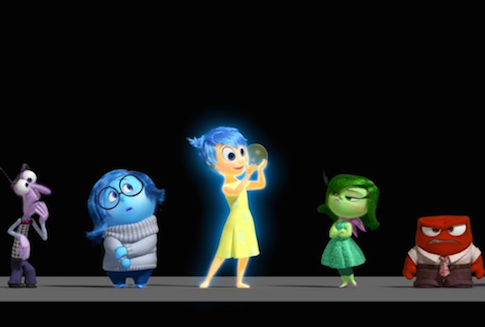As a red-blooded American male, I take a great deal of pride in being emotionally dead inside. This is especially true when it comes to films: A man tearing up during a touching moment on the big screen is entirely unacceptable, unless, of course, one happens to be watching the closing moments of Field of Dreams.
But damn if Pixar doesn’t have a roadmap to my tear ducts.
Time and again the computer-animation geniuses have managed to get the waterworks going in your humble reviewer. From Toy Story 3’s closing moments as Andy lets his friends go to Up’s remarkable opening montage to Ratatouille’s snobby critic’s celebration of the simpler pleasures in life, the demented geniuses at Pixar know just how to push my buttons.
Needless to say, I was extremely concerned to discover that Pete Docter, the director of Up, had crafted a movie that is literally about feelings. Inside Out puts us in the head of Riley (Kaitlyn Dias), a young girl whose family moves from Minnesota to San Francisco. We meet Joy (Amy Poehler) shortly after Riley is born; Sadness (Phyllis Smith) is born a few moments later when the young Riley starts crying. Fear (Bill Hader), Anger (Lewis Black), and Disgust (Mindy Kaling) round out the inhabitants of HQ, and the five anthropomorphized emotions control her actions and responses via a control panel situated behind her eyes.
Docter and his crew of animators do a clever job of illustrating how the brain works. Every time a new memory is formed a ball appears, color-coded to the emotion the ball represents; some are filed away to long term at the end of the day, but most are dumped into a giant pit while she sleeps. Additionally, every once in a while Riley creates special "core memories" that go on to constitute important facets of her personality (her relationship with her parents, her love for hockey, etc.).
Joy has the run of the place until the move; afterward, Sadness starts to insert herself into the mix more often. Panic ensues when Sadness touches one of the core memories, briefly turning the ball—and the memory itself—blue. When Joy tries to reassert control, she and Sadness both are sucked deep into the brain. Bereft of her emotional supports, Riley spins out of control in her new surroundings.
Needless to say, Inside Out is an emotionally affecting piece of work. Particular credit in this regard goes to Bing Bong (Richard Kind), Riley’s long-forgotten imaginary friend who helps Joy and Sadness navigate their way back to HQ. In a way, his character arc serves as the personification of Riley’s maturity, a reminder that growing up sometimes means letting go of—or, simply, forgetting—things we once loved.
Picking at that sense of nostalgia—as Don Draper reminds us, a word that literally means "old wound" in the Ancient Greek—is what Pixar excels at. No studio on the planet is better at finding and exploiting that sense of the aging process so as to generate an emotional response. The clever, funny, and, yes, touching Inside Out is no exception.
